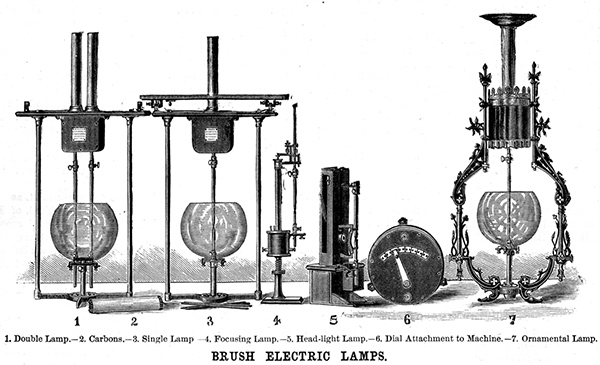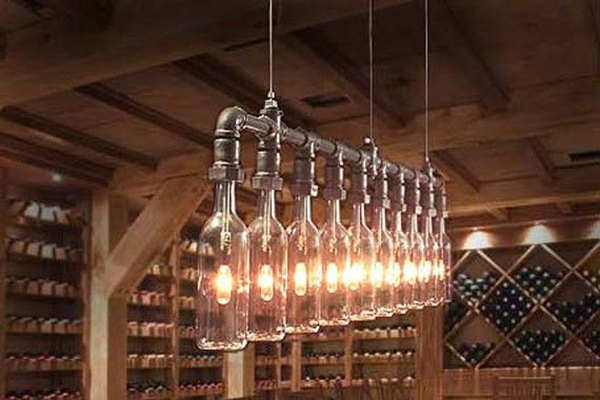A quick flash through time looking at the first electric lamp up to the modern day approach to lighting.
Lighting can literally light up your life by completely changing the mood of a room. Just as theatre lighting transforms a stage, lights in a room can alter colour and emphasise texture. A soft lighting scheme can be calming and soothing or, at the other end of the scale, dramatic shades can be exciting or daring. Importantly for interior designers, lighting affects the perception of space. Small rooms can be made to feel larger, large rooms smaller. By using clever lighting, ceilings can be made to appear higher or lower. Also lighting can highlight features or downplay others.

AMC Pacific Place cinema by James Law Cybertecture International 2010
The first electric lamp
Looking back in history, the first electric lamp was the carbon-arc lamp, demonstrated in 1801 by Sir Humphrey Davy, an English chemist. Lighting the way for electric lights, the incandescent lamp was developed by Sir Joseph Swan in England and Thomas Edison in the US. Edison patented his invention in 1880 and therefore helped shape the future of lighting.

The move to more efficient lighting
As the lack of efficiency of incandescent bulbs became more of an issue, scientists looked to develop new technologies that didn’t waste as much energy and provided a better overall light source. There was a lightbulb moment when the fluorescent light was first invented.
The most recent addition to the lighting market are light-emitting diode (LED) products. Due to their significantly increased energy efficiency, LEDs have become the go-to green option.
Aesthetics aside, lighting is an important financial thorn in the side for businesses as it can take up as much as 50 per cent of the firm’s electricity consumption, so it is important for company owners to understand the benefits of switching to cost-effective, energy efficient lighting solutions.
Mixing up metals – or not?
Traditional finishes for light fixtures include brass, copper, nickel, bronze and chrome or even gold. Oil-rubbed metals, matte or shiny finish, a smooth satin sheen or textured finishes are some of the options. Combining the best of both worlds; style and substance the PVD (Physical Vapour Deposition) Oil Rubbed Bronze finish was launched in early 2003. It comes in a popular colour choice and will stand the test of time. Different pre-treatments of the surface before the PVD process is carried out can adjust shades from a light brown to dark brown or black. The coatings works best on chrome plated brass or directly over stainless steel.
However is it alright to mix metal finishes on door hardware and light fittings etc, in a room or even the whole house? Designers seem to be quite divided on this. At one end of the spectrum, you have the “all metals must be the same” designers, and on the other end, are the “mix it up for fun” brigade. However it pays to experiment as some different coloured metals go together, for instance brown and silver are colours that work in unison, so why not?

A suspension lamp made from wine bottles
The components of a lighting scheme
A successful lighting scheme is made up of several layers: natural, general, accent and task light. Ambient or background lighting plays the part of daylight and is usually provided by a central pendant light, a hangover from the days of gas lamps. It can create lighting problems as it creates a bland, flat effect. However, if you supplement general lighting with some or all of the other types, you’ll end up with the best results. Try ceiling-mounted bowls, wall lights, downlighters, uplighters and standard lamps.
Accent gives texture, focus and shape to general lighting, adding depth and shade. It’s formed by a mixture of halogen spotlights, downlighters, uplighters, tracks and table lamps. It can highlight architectural features, furniture and works of art.
Task lighting is what you need to do a specific job, whether it’s reading, working at a computer, eating or drinking. Obviously, visual tasks are easier to perform when the work area is well lit. Task lighting also eases eye strain when it is installed with care, which can make the work environment more pleasant.

Combination of lighting sources for opticians premises
PVD process to maximise light output
Some of the most exciting lighting technology includes using reflective aluminium strips and light fittings to boost lighting efficiency by 10 to 20 per cent, therefore minimising energy wastage. The aluminium strip/fitting is treated under vacuum (the PVD process) with specially developed treatments to maximize coating adhesion and, depending on product type, is vacuum coated with a super reflection layer of either 99.99% pure aluminium or 99.99% pure silver. The super reflectability is provided by the metallic layers and also means the coating has protection from wear and tear.

Topix by Deltalight